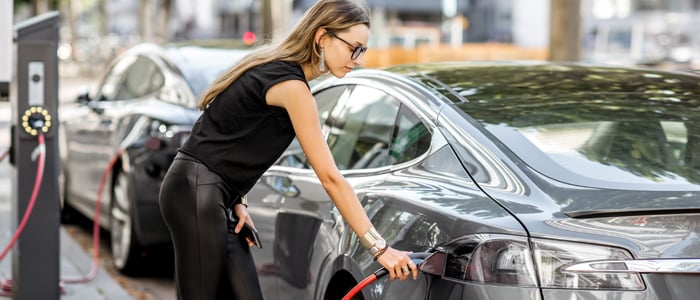
Electric vehicle use is on the rise. How’d we get here and where are e-cars taking us in the future?
Defined as a vehicle that uses energy stored in rechargeable batteries, today's e-cars weren’t welcomed into the mainstream until quite recently. And while many still believe the auto industry is moving in a diesel-powered direction with the increasing popularity of SUVs and trucks, consumers are also starting to take notice of the benefits e-cars present.
Here are a few of the reasons why e-cars are trending up.
The juice is loose
In the past, many consumers who might be interested in e-cars were often turned off by a critical shortcoming: the lack of on-the-go charging availability. While gas stations remained ubiquitous, charging stations were hard to come by, forcing drivers to carefully map out where they could juice up their ride. Thankfully, the increase of charging locations and the introduction of advances like near-field charging technology has alleviated that concern. Additionally, electric cars have made significant strides in their ability to travel farther on a single charge.
Not only is electric power now more available and longer-lasting—it’s cheap. A fraction of the cost of a tank of gas at around 10 cents per kilowatt, per hour of energy—or a total of about $2.75 for a full charge—e-cars offer superior fueling affordability.
It’s time to go green
When was the last time you saw some jalopy dragging down the road, belching out clouds of black exhaust? Been a minute? While they’re still out there, with the help of manufacturers’ move toward green, beat up gas guzzlers are becoming far less common.
And consumers have gotten the memo, with now 71 percent thinking ‘green’ when making a purchase. Reducing the strain on our world with the potential to cut harmful emissions 45 percent by 2025, e-cars have become especially attractive to environmentally-conscious users.
More options than ever
Even with the attraction of saving both the planet and some extra cash, in the past, e-cars were out of the question for many consumers because they didn’t fit their lifestyle. It wasn’t long ago that most e-cars were smaller sedans with little to no space and very short charging ranges—but the industry has begun addressing those issues.
Now, manufacturers like Tesla and Fisker are focusing on bringing luxury and comfort to the e-vehicle market, while other companies such as Rivian have introduced electric pickup trucks and SUVs built with the outdoors in mind. Chevy has also rolled out more electric options, including the Bolt EV with an impressive 238-mile range. And consumers have responded with electric vehicles on the road surpassing 3 million in 2018—a 50 percent increase over 2016.
As e-cars become more affordable and more common, what does this mean for insurance rates? Well, currently, a few key factors could influence coverage costs—namely a lack of relevant data and fewer available parts. Without existing data, electric vehicle risks are difficult to determine; and, without easily accessible parts, e-car repairs will be costlier. Both of these factors can lead to higher rates. That said, some insurers believe the absence of gasoline and the presence of speed restrictions, make e-cars a reduced risk compared to standard vehicles.
At the end of the day, while electric cars may cost more than a standard vehicle up front, they can likely save drivers money in the long run.
For more current automotive trends, check out our blog on auto tech milestones that have changed the insurance industry!



